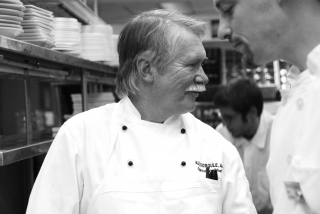
Creating a Change Mindset in Culinary Education
31 January 2024“Without change there is no innovation, creativity, or incentive for improvement.” – William Pollard
Then why are people so resistant?
By Paul Sorgule, MS, AAC
Feedback & comments: This email address is being protected from spambots. You need JavaScript enabled to view it.
Whether young or old, veteran teacher or fresh in the field, progressive or conservative – the word change can send shivers up your spine. We may know it is inevitable, yet when it impacts our daily routine, our operation methods, or the base of knowledge we spent years acquiring – change doesn’t sit well.
How we view and approach change is the single most important factor in determining its success or at least how quickly it is adopted. Often, change is so pervasive and inevitable it will eventually happen with or without our active support. Yet, many view change as a negative – something to resist and avoid. Change is the key to progress, growth and, in some cases, survival.
All businesses and industries not only face change at various points in time – many plan for it. The lifecycle of a product or service can be measured in terms of its initial impact in the marketplace, its growth phase, a time when support for it wanes and levels off, and then decline that can be gradual or dramatic depending on your business environment. The most consistently successful operators are those who expect change to take place and begin to formulate a new product, service, or plan during the height of current growth. This provides a seamless transition from the old to the new.
So, how do operators, in this case those of us in culinary education, create a mindset for change within our organizations? How do we set the stage for reinvention? Here are some thoughts:
Know the environment
Do your research first. Study the competition, look for patterns that indicate a wholesale need for change, look at demographic shifts, and compile quantitative and qualitative data that supports a need to move in a new direction.
Establish the reasons for change
Those uncomfortable with change and cautious about moving in a new direction need to understand the “why” behind a purported need. Advocates will become skeptical without reasons behind your initiatives.
Know there will be resistance
It’s human nature to resist change. Some may simply hope any plans will go away while others may actively try to thwart your efforts. Expect it, plan for it, keep an eye on it, and be proactive rather than reactive.
Understand not all resistance is logical
Sometimes you may be unable to convince skeptics to see your reasoning. Their arguments may very well be based on feelings without facts. Just know you may never be successful in changing their outlook.
Know some resistance is warranted
However, some who are uncomfortable with change may have concerns that are real and worthy of your attention. Embracing their logic could help to improve your change initiative and win them over once they sense their voice has an audience and is being heard.
Communicate and involve
Avoid keeping secrets from the group or feeding perceptions you are keeping secrets. Share everything openly and show a willingness to always listen to objections. The goal is to implement changes that benefit all stakeholders.
Mobilize advocates without isolation
Nurture those who “get it” and give them a role in the change process. It is, however, important to never build these relationships while ignoring those who are less convinced you have it right.
Win over the skeptics – all thoughts have value
Even though some may never see the need for change or your logic in approaching it, it doesn’t mean you shouldn’t try. Inquire as to the reason for their skepticism and seek to find digestible answers. Just the fact that you listen and try to address their concerns may be enough to win them over or at least open their minds.
There are also words and phrases to avoid if change is to take hold. Make sure the parameters for building this change mindset are free of the following:
- We (i) can’t.
- That won’t work.
- We tried that before.
- If it isn’t broken, why fix it?
The fear of change is real; always remember that. Whenever change impacts a person’s comfort zone then the mindset will be challenged. Before you propose any significant change in your work environment, ask the following question: “How will this impact the people around me, including administration, faculty, staff, students, employers, and supporters?”
An operations chef who wants to introduce a new menu must, as an example, consider the impact of this move on prep and line cooks, service staff, inventory, vendors, menu price sensitivity, complementary wines, marketing, and perceptions of new and regular guests. Make sure you do your homework and have rational, well-thought-out responses to their fears. If you fail to do this, then success will be hard to achieve.
“Without change there is no innovation, creativity, or incentive for improvement. Those who initiate change will have a better opportunity to manage the change that is inevitable.”
– William Pollard (American Physicist)
In the spirit of change and a fresh start in 2024 – “Think Tank” is being re-branded as “Future Thinking in Education.” The articles offered will continue to focus on the macro issues facing leadership in culinary education and how decision makers might prepare for and implement change in a rapidly evolving education landscape.
PLAN BETTER – TRAIN HARDER – EMBRACE CHANGE
Paul Sorgule, MS, AAC, president of Harvest America Ventures, a mobile restaurant incubator based in Saranac Lake, N.Y., is the former vice president of New England Culinary Institute and a former dean at Paul Smith’s College. Contact him at This email address is being protected from spambots. You need JavaScript enabled to view it..
